#21: Reveal Characters Through Tension
There are countless blog posts and books which give step-by-step guides on how to create a good first impression. In stories too, characters have first impressions of each other which can have a huge impact on their relationships and the plot (the original version that Jane Austen wrote of Pride and Prejudice was actually titled First Impressions.)
Yet another way to think about first impressions is the first impressions that characters leave on the reader. Whether a character is major or minor, whether they are introduced at the beginning of the book or near the end, our first impressions of characters begin the process of revealing them to us.
Revealing Characters to the Reader
But how do you reveal character, and how, as a writer, do you make sure that you leave the right first impression on readers? (Unlike in meeting people in real life, in a novel the goal is not necessarily to leave the best first impression, but rather, a first impression that helps us understand the essence of someone’s character, and often foreshadows their journey or the role that they will play in the story.)
One of the fastest ways to truly know someone is to see what they do and how they act in moments of struggle or tension. It is these moments that often draw out or reveal true or fundamental character. (I remember receiving very similar dating advice—you want to make sure that you see the person you are dating in hard or challenging situations, not just good ones.)
In Northanger Abbey, the narrator introduces us to Catherine Morland in the first chapter, but the first time we see Catherine Morland in scene rather than summary is in Chapter 2.
Catherine has just arrived in Bath, where she is staying with her friends, Mr. and Mrs. Allen. They go to a public ball, and unfortunately, they do not know anyone. Mr. Allen immediately goes off on his own, leaving Catherine and Mrs. Allen to fend for themselves.
Gif from the 1987 film adaptation of Northanger Abbey
“How uncomfortable it is,” whispered Catherine, “not to have a single acquaintance here!”
“Yes, my dear,” replied Mrs. Allen with perfect serenity, “it is very uncomfortable indeed.”
“What shall we do?—The gentlemen and ladies at this table look as if they wondered why we came here—we seem forcing ourselves into their party.”
“Ay, so we do.—That is very disagreeable. I wish we had a large acquaintance here.”
“I wish we had any;–it would be somebody to go to.”
Jane Austen has efficiently and effectively revealed key elements of Mrs. Allen’s and Catherine’s characters.
First, Mrs. Allen:
- Mrs. Allen does not take action, even when she sees that her companion, who is relying on her to take the lead, is uncomfortable.
- She has “perfect serenity” which can either demonstrate a great Zen state and that she is not bothered by outside influences and struggle—or this could demonstrate a lack or failing on her part.
Next, Catherine:
- Her wants are revealed—she wants to know people, she wants to dance and have a good experience, she wants to feel comfortable in her surroundings.
- She is currently more passive than active. She lets others control or dictate her actions (which is something that will become an important plot point later).
- She is a sympathetic character, an underdog, and we want her to succeed.
- She is concerned about propriety and her place in society. While one of the things Catherine must learn over the course of the novel is how to read people and situations, she isn’t starting from nothing.
Later in the scene, near the end of the ball, Mr. Allen returns:
“Well, Miss Morland,” said [Mr. Allen], directly, “I hope you have had an agreeable ball.”
“Very agreeable indeed,” she replied, vainly endeavouring to hide a great yawn.
This brief exchange reveals more about Catherine:
- She is more open with Mrs. Allen than Mr. Allen
- Mr. Allen is unaware of the situation
- She is kind and considerate. She is not a complainer or whiner, and tries to put a good spin on things, even as she fails to suppress a yawn. This is endearing and makes her more sympathetic.
- The chapter closes with everyone leaving, and with Catherine’s attempt to frame her own experience:
She was looked at, however, and with some admiration; for, in her own hearing, two gentlemen pronounced her to be a pretty girl. Such words had their due effect; she immediately though the evening pleasanter than she had found it before—he humble vanity was contented—she felt more obliged to the two young men for this simple praise than a true quality heroine would have been for fifteen sonnets in celebration of her charms, and went to her chair in good humour with everybody, and perfectly satisfied with her share of attention.
This paragraph is brilliant, because Catherine begins this scene with struggle: she is stressed and worried, and yet this final paragraph shows that she is not one to be crushed.
Catherine is both naïve and optimistic, inexperienced and loveable. In just this short scene, Austen has managed to set up some of the core tensions that make Catherine a three-dimensional character whose story is worth following.
One of the biggest advantages of using a moment of tension or challenge to reveal character is that is demonstrates characters’ strengths and weaknesses, and it sets the stage for the tools and limitations that will accompany them on their journey. As characters are pushed and pulled by outside and inside forces, we see what they are really made of.
Struggle or tension can manifest in numerous forms, including:
These scenes are effective not just for the first time we meet a character, but throughout the story. If you want to show a character’s change or growth, then do it in a scene that has tension or struggle.
Sometimes you may also want to intentionally write a character that has given of a false first impression to the reader, that disguises their true character (even while containing hints of it). In this case, have moments of tension later that reveal their true character to the reader.
Exercise 1: Choose a novel or short story and print a copy of the first moment of tension, struggle, or challenge for the character. Now, find and print a copy of the last big moment of tension or struggle for this character in the novel (this is often but not always during the climax).
Mark up these scenes, underlining and annotating with what reveals character (wants, needs, multidimensional, strengths/weaknesses, active/passive, sympathetic/unsympathetic). Compare these scenes and how the character has changed throughout the course of the novel. How does the first scene of tension and struggle set up the final scene of tension and struggle?
Exercise 2: Jane Austen is a master of creating tension and struggle from small, everyday moments, and using this tension to express and develop character. List five everyday objects from the same category (i.e. kitchen items, toys, technology, apparel). Write a short scene which includes at least two of these objects and which also uses tensions and struggle to reveal character.
Exercise 3: If you have a draft of a short story or novel, analyze what types of tension you use throughout the story. Is the tension or struggle manifested by:
- Two characters wanting different things
- A small or large problem
- A lack or a need that is manifest in a particular situation
- A change in situation that tests or challenges a character
- A goal or task which is challenging and requires effort
- Other
Do the sorts of struggles shift over the course of your novel? How does this affect the main character’s inner journey? Is the progression satisfying?

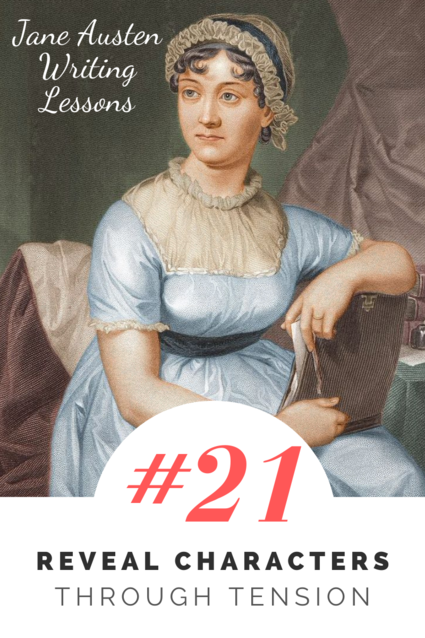
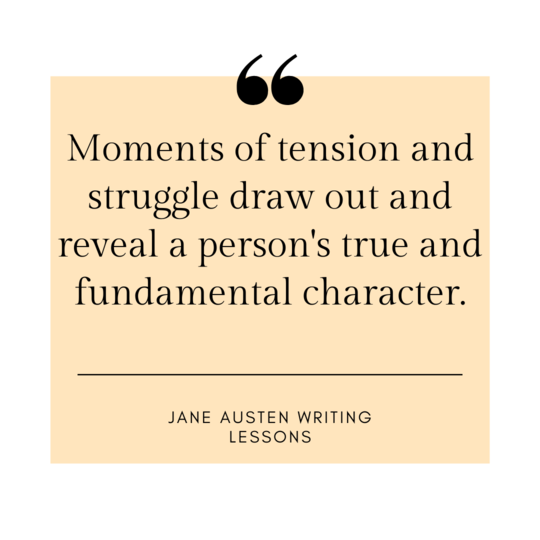

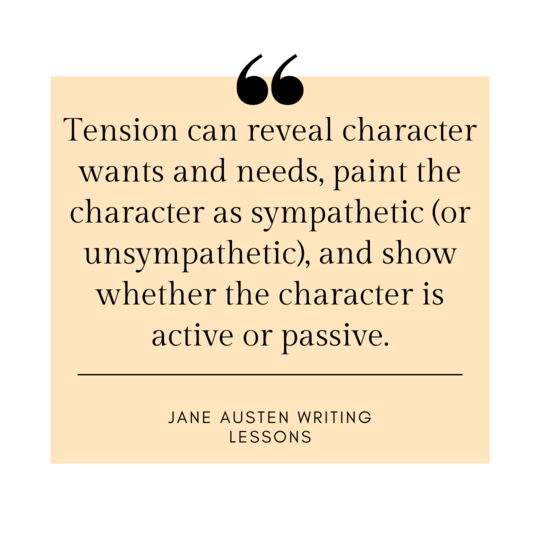
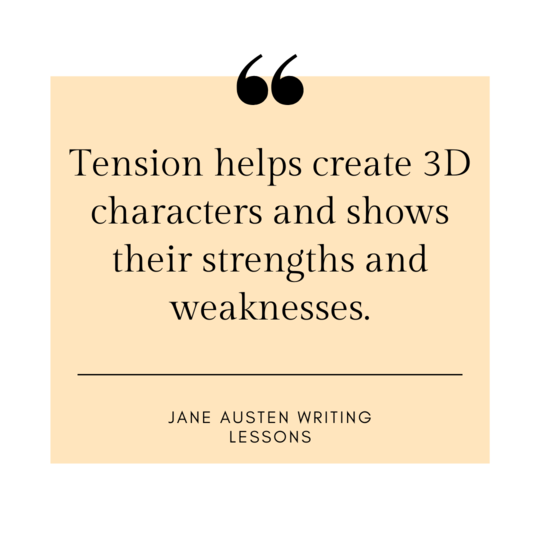
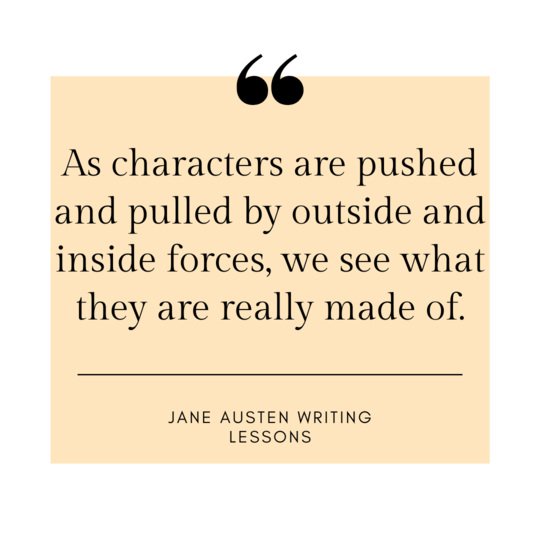

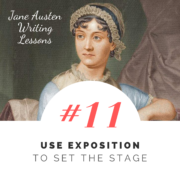
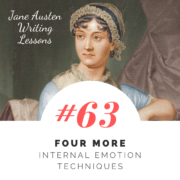
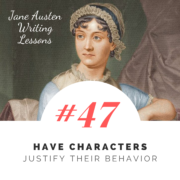
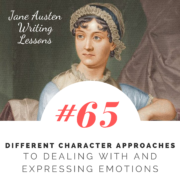
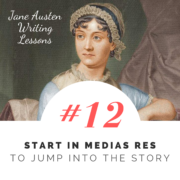

Leave a Reply
Want to join the discussion?Feel free to contribute!